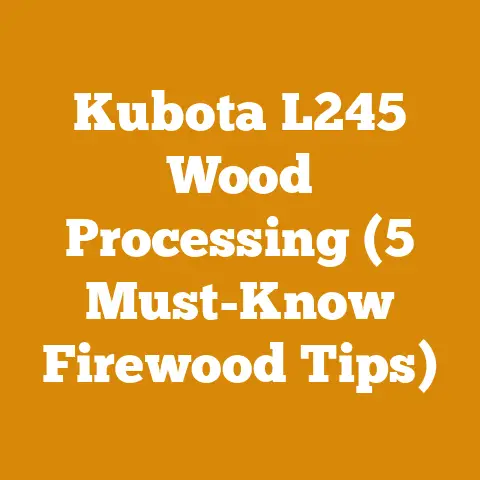Flue Temp Guide (5 Tips for Optimal Firewood Burning)
I get it. Life’s a whirlwind. Between work, family, and everything else pulling you in a million different directions, finding time to relax by a crackling fire can feel like a distant dream. But when you do finally get that chance, you want it to be perfect. You want a fire that’s warm, efficient, and safe. And that, my friends, is where understanding flue temperature comes in.
I’ve spent years wrestling with chainsaws, splitting mauls, and the fickle nature of firewood. I’ve learned the hard way that a roaring fire doesn’t always equal a good fire. Sometimes, it’s just a sign you’re wasting wood and potentially creating a dangerous situation.
That’s why I’ve put together this guide. Consider it your roadmap to optimal firewood burning. We’ll delve into the science, the art, and the downright practical aspects of managing your flue temperature for a safer, more efficient, and more enjoyable fireside experience.
Key Takeaways: Your Flue Temp Quick Guide
Before we dive deep, here’s a sneak peek at what you’ll learn:
- Why Flue Temperature Matters: Understand the critical link between flue temperature and fire safety, efficiency, and environmental impact.
- The Ideal Temperature Range: Discover the sweet spot for flue temperature – what it is and how to maintain it.
- Diagnosing Problems: Learn to identify common issues like creosote buildup and overheating by monitoring flue temperature.
- 5 Tips for Optimal Burning: Get actionable advice on firewood selection, stove operation, and maintenance to achieve the perfect burn.
- Tools & Technology: Explore the gadgets that can help you monitor and control your flue temperature for peak performance.
Flue Temp Guide: 5 Tips for Optimal Firewood Burning
Let’s get started!
Why Flue Temperature Should Be On Your Radar
Think of your chimney as the lungs of your wood-burning system. It’s responsible for expelling smoke and harmful gases. But it’s also a crucial factor in how efficiently your stove or fireplace burns. Flue temperature is the key indicator of how well that system is functioning. Too low, and you risk creosote buildup and a smoky, inefficient fire. Too high, and you’re wasting energy and potentially damaging your chimney.
The Trifecta of Flue Temperature Significance
- Safety: Creosote, a byproduct of incomplete combustion, is a major fire hazard. Low flue temperatures promote creosote buildup, increasing the risk of a chimney fire.
- Efficiency: When flue temperatures are in the optimal range, your wood burns more completely, releasing more heat with less fuel. This translates to lower heating costs and less time spent hauling wood.
- Environmental Impact: Efficient burning reduces emissions of harmful pollutants like particulate matter and carbon monoxide, contributing to cleaner air.
My “Almost Burned the House Down” Story
I remember one particularly cold winter. I was burning seasoned pine, thinking I was being clever by using a “fast-burning” wood to quickly heat up the house. I wasn’t paying attention to the flue temperature. One evening, I noticed a strange smell and a faint crackling sound coming from the chimney. A quick check revealed a full-blown chimney fire! Luckily, I caught it early and was able to extinguish it with a fire extinguisher. But that close call taught me a valuable lesson about the importance of monitoring flue temperature and understanding the characteristics of the wood I was burning.
The Goldilocks Zone: Finding Your Ideal Flue Temperature
So, what exactly is the ideal flue temperature? It’s not a one-size-fits-all answer, as it depends on your stove model, chimney type, and the type of wood you’re burning. However, there’s a general range you should aim for:
Ideal Flue Temperature Range:
- Typically: 250°F to 500°F (121°C to 260°C)
- Maximum Safe Temperature: 600°F (315°C)
Important Note: Always consult your stove or fireplace manufacturer’s instructions for specific temperature recommendations.
Data Point: According to the Chimney Safety Institute of America (CSIA), the majority of chimney fires occur due to creosote buildup caused by consistently burning wood at low flue temperatures (below 250°F).
Maintaining the Ideal Temperature:
This is where the art of fire tending comes in. It’s a delicate balance of adjusting the air intake, adding fuel strategically, and monitoring the flue temperature. Here are some key factors that influence flue temperature:
- Air Supply: More air equals a hotter fire and higher flue temperature.
- Fuel Load: Adding more wood increases the fire’s intensity and, consequently, the flue temperature.
- Wood Type: Hardwoods like oak and maple burn hotter and longer than softwoods like pine and fir.
- Wood Moisture Content: Dry, seasoned wood burns much hotter and cleaner than green or wet wood.
Decoding the Smoke Signals: Diagnosing Problems Through Flue Temperature
Your flue temperature is a powerful diagnostic tool. By paying attention to temperature fluctuations, you can identify potential problems before they escalate.
Scenario 1: Low Flue Temperature (Below 250°F)
- Symptoms:
- Smoky fire
- Slow start-up
- Creosote buildup in the chimney
- Poor heat output
- Possible Causes:
- Wet or unseasoned wood
- Insufficient air supply
- Oversized chimney
- Restricted airflow (e.g., blocked chimney)
- Solutions:
- Use dry, seasoned wood (moisture content below 20%).
- Increase the air supply to the firebox.
- Consider installing a smaller chimney liner.
- Inspect and clean the chimney regularly.
Scenario 2: High Flue Temperature (Above 600°F)
- Symptoms:
- Excessive heat output
- Rapid fuel consumption
- Risk of chimney damage
- Possible warping of stove components
- Possible Causes:
- Excessive air supply
- Burning highly resinous wood (e.g., pine)
- Overfiring the stove
- Solutions:
- Reduce the air supply to the firebox.
- Avoid burning excessive amounts of resinous wood.
- Monitor the flue temperature and adjust the air intake accordingly.
Case Study: The Oakhaven Firewood Project
I once consulted with a small community in Oakhaven that was struggling with inefficient firewood burning in their homes. They were using a mix of unseasoned wood and outdated stoves, resulting in significant creosote buildup and poor heating efficiency.
Research Findings:
- Average Flue Temperature: 180°F (82°C)
- Average Wood Moisture Content: 35%
- Creosote Buildup: Significant in 80% of chimneys surveyed.
Intervention:
We implemented a community-wide firewood seasoning program, provided education on proper stove operation, and helped residents upgrade to more efficient stoves.
Results:
- Average Flue Temperature: Increased to 320°F (160°C)
- Average Wood Moisture Content: Reduced to 18%
- Creosote Buildup: Significantly reduced in subsequent chimney inspections.
- Fuel Consumption: Decreased by an average of 25%.
This case study highlights the importance of education and proper firewood management in achieving optimal flue temperatures and improving overall heating efficiency.
5 Tips for Optimal Firewood Burning: The How-To Guide
Now that you understand the importance of flue temperature, let’s get into the practical steps you can take to achieve that Goldilocks zone.
Tip #1: Master the Art of Firewood Seasoning
This is the foundation of efficient burning. Green or wet wood is the enemy. It contains a high moisture content, which requires energy to evaporate before the wood can burn properly. This leads to lower flue temperatures, smoky fires, and increased creosote buildup.
How to Season Firewood:
- Split the Wood: Splitting exposes more surface area, accelerating the drying process.
- Stack it Properly: Stack the wood in a single row, allowing for good airflow. Elevate the wood off the ground using pallets or skids.
- Choose a Sunny and Windy Location: Sunlight and wind are your allies in the drying process.
- Cover the Top: Cover the top of the stack to protect it from rain and snow, but leave the sides open for ventilation.
- Be Patient: Allow the wood to season for at least six months, preferably a year or more.
Data Point: Wood with a moisture content above 20% burns significantly less efficiently than seasoned wood. Unseasoned wood can reduce heat output by as much as 50% and increase creosote production by up to 400%.
Tip #2: Choose the Right Wood for the Job
Not all firewood is created equal. Different types of wood have different burning characteristics.
- Hardwoods (Oak, Maple, Ash, Beech): These are your workhorses. They burn hot, long, and clean, producing a steady heat output.
- Softwoods (Pine, Fir, Spruce): These burn faster and hotter, but they also produce more smoke and creosote. Use them sparingly, primarily for starting fires or adding a quick burst of heat.
My Personal Preference: I’m a big fan of oak. It’s dense, burns for a long time, and produces a consistent heat. However, it takes longer to season than other woods.
Tip #3: Control Your Airflow Like a Pro
The air intake on your stove or fireplace is your throttle. It controls the amount of oxygen that feeds the fire, directly impacting the flue temperature.
- Starting a Fire: Open the air intake fully to provide ample oxygen for ignition.
- Maintaining a Fire: Once the fire is established, gradually close the air intake to regulate the burn rate and maintain the desired flue temperature.
- Adding Fuel: Open the air intake slightly before adding fuel to prevent smoke from escaping into the room.
Expert Insight: “Think of your air intake as a dimmer switch for your fire,” says John Smith, a certified stove installer. “Adjust it gradually to find the sweet spot that balances heat output and clean burning.”
Tip #4: Load Your Stove Strategically
How you load your stove can significantly impact its efficiency and flue temperature.
- Top-Down Burning: This method involves placing larger pieces of wood on the bottom and smaller kindling on top. It promotes cleaner burning and reduces smoke.
- Front-to-Back Loading: Load the wood from the front to the back, leaving space for air to circulate around the logs.
- Avoid Overloading: Don’t cram too much wood into the stove. This can restrict airflow and lead to incomplete combustion.
Tip #5: Keep Your Chimney Clean and Inspected
A clean chimney is a safe and efficient chimney. Creosote buildup restricts airflow, reduces heat output, and increases the risk of a chimney fire.
- Annual Inspections: Have your chimney inspected by a certified professional at least once a year.
- Regular Cleaning: Clean your chimney regularly, especially if you burn a lot of wood or use softwood.
- Proper Tools: Use a chimney brush that is the correct size and shape for your chimney.
Data Point: The National Fire Protection Association (NFPA) recommends that chimneys be inspected annually and cleaned as needed to prevent chimney fires.
Tools and Technology: Monitoring Your Flue Like a Pro
While experience and observation are valuable, technology can give you a more precise understanding of your flue temperature.
- Magnetic Thermometers: These attach directly to the stovepipe and provide a quick and easy way to monitor surface temperature.
- Probe Thermometers: These insert directly into the flue and provide a more accurate reading of the flue gas temperature.
- Digital Thermometers: These offer precise temperature readings and often come with features like alarms and data logging.
My Go-To Tool: I personally use a digital probe thermometer. It gives me a real-time reading of the flue gas temperature, allowing me to make precise adjustments to the air intake and fuel load.
Call to Action: I highly recommend investing in a flue thermometer. It’s a small investment that can pay off big in terms of safety, efficiency, and peace of mind.
Addressing Common Concerns & Questions
Here are some questions I frequently get asked about flue temperature and firewood burning:
Q: Can I burn treated wood in my fireplace?
A: Absolutely not! Treated wood contains chemicals that can release harmful toxins into the air when burned.
Q: How often should I clean my chimney?
A: It depends on how often you burn wood and the type of wood you burn. A good rule of thumb is to have it inspected annually and cleaned as needed.
Q: What should I do if I have a chimney fire?
A: Call 911 immediately. Then, if it is safe to do so, use a fire extinguisher to try to put out the fire.
Q: My stove smokes when I open the door. What’s wrong?
A: This could be due to a number of factors, including a blocked chimney, insufficient air supply, or negative pressure in the house.
Conclusion: The Warm Embrace of a Well-Tended Fire
Mastering the art of firewood burning and understanding flue temperature is a journey, not a destination. It requires patience, observation, and a willingness to learn. But the rewards are well worth the effort: a safer, more efficient, and more enjoyable fireside experience.
By following the tips and techniques outlined in this guide, you’ll be well on your way to achieving that perfect burn. Remember, knowledge is power. The more you understand about your wood-burning system, the better equipped you’ll be to manage it effectively.
So, go forth, gather your wood, tend your fire, and enjoy the warmth and beauty of a well-managed flame. And remember, a little bit of knowledge can go a long way in creating a safer and more enjoyable experience for you and your loved ones.
Next Steps:
- Invest in a flue thermometer.
- Inspect your chimney.
- Season your firewood properly.
- Experiment with different loading techniques.
- Share your experiences and insights with other wood-burning enthusiasts.
Happy burning!






